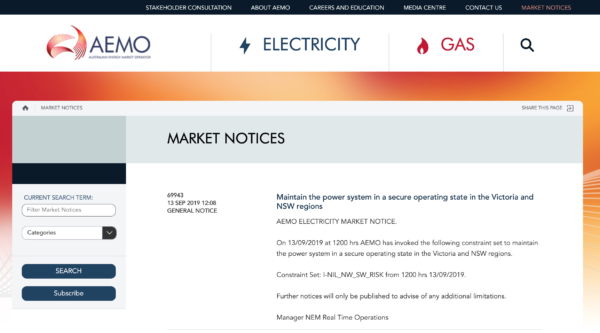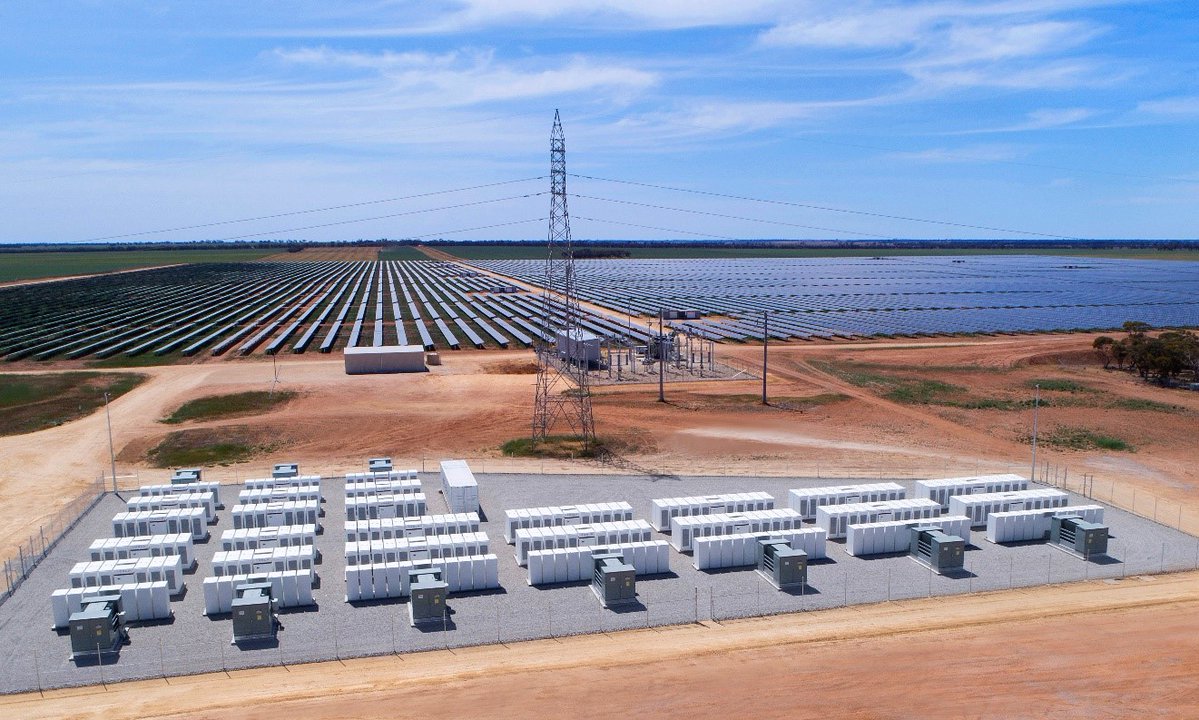On Friday, the Australian Energy Market Operator, citing system strength issues, reduced the permitted output from five solar farms in Victoria and New South Wales to half their output.
The somewhat cryptic Market Notice 69943 was posted just after noon, and affects the operations of Gannawarra, Broken Hill, Karadoc, Wemen and Bannerton solar farms.

Image: AEMO
Calls by pv magazine to AEMO have not been able to ascertain when the curtailment will be lifted, but on Friday the market operator was said to be working with a number of solar farms and network service providers to manage voltage fluctuations in the two states, which have apparently been causing concerns for at least a fortnight.
In a statement issued to stakeholders late on Thursday, Sept 12, AEMO said, “Until the fluctuations are resolved, AEMO will need to partially constrain the affected generators to manage power system security.”
The problem was identified in the Victorian and NSW 220kV electricity network, and AEMO says it has been working with all impacted generators in anticipation of “an expedited remediation” to reduce the impact and timeframe of constraints.
Owned by Wirsol and Edify Energy, Gannawarra’s 60 MWdc solar farm was producing 50 MW of energy last week and had its output reduced 25 MW.
The project is integrated with a 25 MW/ 50 MWh Tesla Powerpack battery, and at its official opening in June, Victoria’s energy minister, Lily D’Ambrosio, said, “By investing in renewable energy and storage technology, we are continuing to modernise our electricity grid, strengthen our energy security and deliver real action on climate change.”
Modernisation of the National Electricity Market transmission system is a slow process, beset by rules designed for previously rare additions of generation to Australia’s mid-20th century, coal-fired grid; not for the transition to lowest-cost, low-carbon generators which are distributed in regions of best resource not necessarily well served by transmission and distribution infrastructure.
At the Australian Clean Energy Summit (ACES) in late July, Andrew Stiel, head of Energy Markets and Offtake at Edify, explained the difficulties of trying to use storage technology to manage the delivery of energy to the grid, and thereby potentially mediate the effects of marginal loss factors and curtailment on solar-farm economics.
Stiel said, “I’m sure it’s occurred to most that perhaps the addition of a storage unit behind the existing point of connection might be a neat way to manage if not an existing, then an impending curtailment situation … but unfortunately it’s not so simple at this stage.”
He outlined the complexities of connecting battery storage alongside a solar generator, saying that regulations designed for another era of energy mean that such capacity is considered a separate renewable asset and allocated its own connection, and is therefore independently dispatched by the market dispatch engine.
“This means,” said Stiel, “that in a curtailment situation when, say, there’s a constraint on the transmission line, the dispatch engine will apply that constraint on the generator battery, not at the substation boundary where the combined utilisation of these assets comes together,” with the result that the “integrated” solar farm must compete with other generators in the area for the right to access the load of that battery.
“There’s a little way to go before we can enable this arrangement to deliver the type of utility that perhaps you’re looking for,” he said … before going on to herald that the solar-rich zone of north-west Victoria “is one area where this may be coming up for lots of generators, who will be looking to manage their curtailment.”
Generators in the region were probably not surprised by Friday’s requirement to reduce their output, but are said to have been shaken by the magnitude of the cuts and their broad application, even to solar farms that have been operating for months (or years, as is the case with AGL’s 53 MW Broken Hill Solar Farm in NSW).
The cuts come at a time when solar developers may have felt they had negotiated complex and often protracted connection procedures, even managed to incorporate 11th-hour requirements for multimillion-dollar synchronous condensers needed to prop up system strength …
To be hit on Friday at the 12th hour with radical curtailment is likely to jeopardise their ability to deliver on power purchase agreements, and simply to balance the books on hundreds of millions of dollars worth of investment made in good faith.
This content is protected by copyright and may not be reused. If you want to cooperate with us and would like to reuse some of our content, please contact: editors@pv-magazine.com.









“On Friday, the Australian Energy Market Operator, citing system strength issues, reduced the permitted output from five solar farms in Victoria and New South Wales to half their output.”
This is the same ignorance CAISO is using for a ‘remedy’ to over generation of solar PV and wind generation, then contracting with ‘fueled’ generators to supply the additional power the grid needs to stay stable. Brilliant, throw away fuel free power with curtailment and buy more costly fueled power to “regulate” the grid voltage. The utilities want their fueled natural gas or coal fired plants with their commodity fuels, instead of clean alternative energy, which, when it is in overgeneration, needs to be stored in an energy storage system instead of curtailed. The utilities are staying rich by selling you “fuel” charges for your power instead of serving you with cheap electricity.